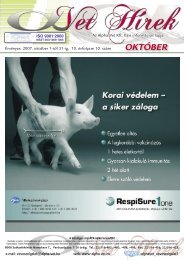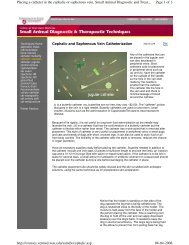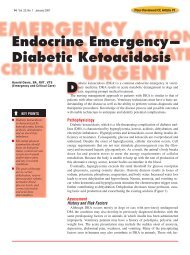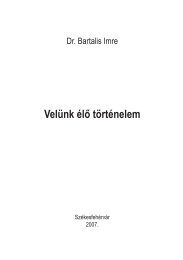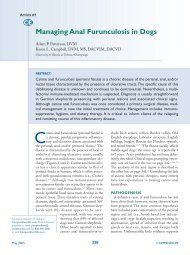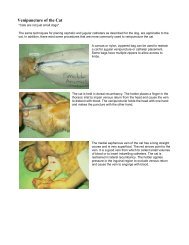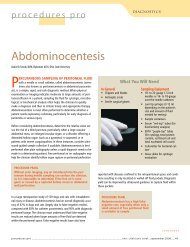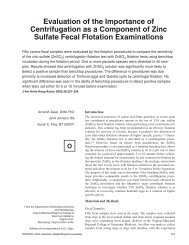evaluating blood films evaluating blood films - Hungarovet
evaluating blood films evaluating blood films - Hungarovet
evaluating blood films evaluating blood films - Hungarovet
- No tags were found...
You also want an ePaper? Increase the reach of your titles
YUMPU automatically turns print PDFs into web optimized ePapers that Google loves.
PEER-REVIEWEDThree-minute peripheral <strong>blood</strong> film evaluation:The leukonTaking a moment to briefly examine white <strong>blood</strong> cells will help you identify conditionssuch as inflammation or stress that may indicate serious disease.Fred L. Metzger Jr., DVM, DABVP(canine and feline practice)Metzger Animal Hospital1044 Benner PikeState College, PA 16801Alan Rebar, DVM, PhD, DACVPDepartment of Veterinary PathobiologySchool of Veterinary MedicinePurdue UniversityWest Lafayette, IN 47907IN THE PREVIOUS ARTICLE, we discussed how toexamine the erythron and thrombon componentsof peripheral <strong>blood</strong> <strong>films</strong>. In this article,we again use a question-based format toguide you in <strong>evaluating</strong> the leukon by assessingwhite <strong>blood</strong> cell (WBC) numbers andmorphology. All five WBC cell types are assessed.Table 1 lists the general patterns ofWBC response under a variety of circumstances.Is the total WBC count elevated,normal, or decreased?Experience is required to accurately estimatecell counts directly from <strong>blood</strong> <strong>films</strong>. Subjectiveanalysis of total WBC numbers may beperformed by counting three to five 20 objectivefields; 10 to 20WBCs/20 field is considerednormal indogs and cats. Anothermethod involvescounting several100oil-immersion monolayerfields and multiplying the averagenumber of WBCs/100oil-immersion field by 2,000 toobtain a final estimated totalWBC count. 1Is a left shift present?A left shift may be the only indicator of activeinflammation in veterinary patients becausetotal WBC and neutrophil counts are frequentlywithin the reference range. Left shifts are characterizedby increased numbers of immatureneutrophils (e.g. band cells, metamyelocytes)in circulation. A left shift is a hallmark of inflammation,so accurately identifying bandcells is extremely valuable. No hematology analyzer(in-house or reference laboratory instrumentation)has been documented to accuratelyidentify band neutrophils; consequently,they must be identified microscopically. On<strong>blood</strong> <strong>films</strong>, the nucleus of a band neutrophiltypically has parallel sides (Figure 1), whereasthe nucleus of a mature neutrophil is distinctlysegmented. One useful approach to differentiateband neutrophils is to estimate the degreeof nuclear indentation. First, identify the narrowestand widest portions of the nucleus. Ifthe narrowest portion is less than one-third ofthe widest portion, the cell is classified as aband cell. 1Is there a monocytosis?The monocyte-macrophage continuum representsthe second major branch of the circulatingphagocyte system (neutrophils arethe first). Monocytes (Figure 2), unlike granulocytes(neutrophils, eosinophils, basophils),are released into the peripheral<strong>blood</strong> as immature cells and then differentiateinto phagocytic macrophages (Figure 3),epithelioid macrophages, or multinucleatedgiant cells.Monocytosis can be another indicator ofinflammation. It may be seen in both acuteand chronic conditions but may also be acomponent of stress leukograms. Conditionsfrequently associated with monocytosis includesystemic fungal diseases (histoplasmosis,blastomycosis, cryptococcosis, coccidioidomycosis,aspergillosis),14




